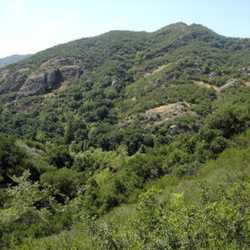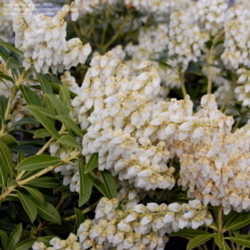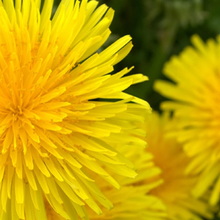Manzanitas (Arctostaphylos) are in the Heath Family (Ericaceae), making them relatives of heath (Erica), heather (Calluna), and blueberries (Vaccinium). They are woody plants from chaparral and forest and range in size from sprawling groundcovers to small trees. There are at least fifty species and most are native to the North American Far West, from Baja California to British Columbia. One species, bearberry (Arctostaphylos uva-ursi), is native to the circumpolar Northern Hemisphere. In many species, the plants have a twisting and gnarled form and the smooth, dark bark contrasts with the small, leathery, light green leaves. The urn-shaped flowers in white or white tinted with pink are an added bonus. Most species bloom in winter or early spring.
 |
Bigberry manzanita berries |
The scientific name, Arctostaphylos means "bear grapes" and the berries are eaten by bears, coyotes, and gray foxes. The berries were also eaten by Native Americans and were a very important food source for some groups. The flesh of some species is meager, so in those cases it was the seeds that were the important food component. The leaves of some species were sometimes used as tobacco. The hard wood was used for tools, pipes, pegs, and hairpins. Later settlers used the berries to make jelly and cider.
 |
Bigberry manzanita blooms as early as December |
Since they are western species, manzanitas have to be adapted to fire. Some species form a burl at the base that resprouts after a fire. Some of these species can live to be 1,000 years old. After many years and repeated fires, the burl becomes a large platform, up to 25 feet across. The species that do not form burls do not survive fire as well, and they must grow back from seed. In fact, often seed will only sprout after it has been subjected to a fire.
Many manzanita species and subspecies are narrow endemics. That means that their native range is very small, sometimes limited to one hill or canyon, and in one case, the last wild specimen was found near a freeway overpass. Some of these rare species and subspecies have been propagated - with no impact on the parent populations - and are now available as nursery plants.
Many species and cultivars are available for the garden, though they are not necessarily always easy to find. For the western resident, I recommend a trip to a native plant nursery or a plant sale of your local native plant society chapter. Keep tabs on the chapter web site for dates and locations.
Manzanita species vary as to which climates they are best suited and according to how well they adapt to garden situations. Varieties of all sizes are available, from groundcovers to small trees. Listing information for all of the species is beyond the scope of this article but much information can be found in Sunset's Western Garden and in Growing California Native Plants.
 |
Blooming "White Lanterns" cultivar |
In nature, manzanitas are usually found in rocky or sandy areas and in the garden, they need excellent drainage. Transplanting should be done in the fall. Chaparral species prefer full sun, though some afternoon shade may be acceptable in hot summer regions. Woodland species should be given light shade. Although manzanitas are xeriscape plants, newly planted plants should be watered every four to seven days. Once established, water once a month were the soil is rocky or the summers hot. Water less often where the soil is heavy or the summers cool.
Manzanitas can be propagated from cuttings. Take 4-inch cuttings of semi-ripe wood of the current season's growth and remove the leaves from the lower half of the cutting. Prepare a flat about four inches deep with a mixture of half sand and half peat. Dip the cuttings in rooting hormone and insert them into the flat. Keep them covered to retain moisture and do not let the soil dry out. Keep the flat in bright light but out of direct sun. Cuttings should be rooted in four to eight weeks. Plants should be set out in the fall. Some species root much easier than others. The following species are reported to root easily: Arctostaphylos densiflora, A. edmundsii, A. hookeri, A. morroensis, A. stanfordiana, and A. uva-ursi.
Propagating manzanitas from seed is a challenge. Seeds need to be pre-treated in order to sprout. Professional growers soak the seeds in sulfuric acid until the seed coat begins to soften. Another method is to plant the seed, cover the flat with pine needles and then set fire to the needles. Cold stratification can be helpful but germination is still erratic and propagation from cuttings is the usual method.
Manzanitas provide four seasons of beauty to the garden. They are evergreen. They have interesting branch and trunk structure. The flowers are abundant and often one of the first things to bloom in winter or spring. The berries of some species are showy. Manzanita adds a touch of the wild beauty of the Far West to the native plant garden or xeriscape border.
Below is a very small sampling of manzanita species and cultivars.
| Species or Cultivar | Form | Zones | Attributes |
| Arctostaphylos columbiana, Hairy manzanita | Shrub to small tree | USDA 7-10, Sunset 4-6, 15-17 | Best for cool summer regions |
| Arctostaphylos densiflora "Howard McMinn", Vine Hill manzanita | Shrub | USDA 6b-10, Sunset 7-9, 14-21 | Probably most readily available variety |
| Arctostaphylos edmundsii "Carmel Sur", Little Sur manzanita | Groundcover | USDA 8-10, Sunset 6-9, 14-24 | Very tolerant of garden water |
| Arctostaphylos glauca, Bigberry manzanita | Shrub to small tree | USDA 7-10, Sunset 4-9, 14-24 | Adaptable |
| Arctostaphylos hookeri, Monterey manzanita | Shrub | USDA 7-11. Sunset 4-9, 14-24 | Some subspecies are rare or endangered in the wild |
| Arctostaphylos manzanita, Common manzanita | Shrub to small tree | USDA 8-10, Sunset 4-9, 14-24 | Adaptable |
| Arctostaphylos nummularia, Fort Bragg manzanita | Shrub | USDA 7-10, Sunset 14-24 | Difficult outside of native range |
| Arctostaphylos uva-ursi, Bearberry, Kinnikinnik | Groundcover | USDA 3-10, Sunset A1-A3, 1-9, 14-24 | Attractive red berries |
| Arctostaphylos "White Lanterns" | Shrub | USDA 7-11. Sunset 4-9, 14-24 | Heat tolerant |

















